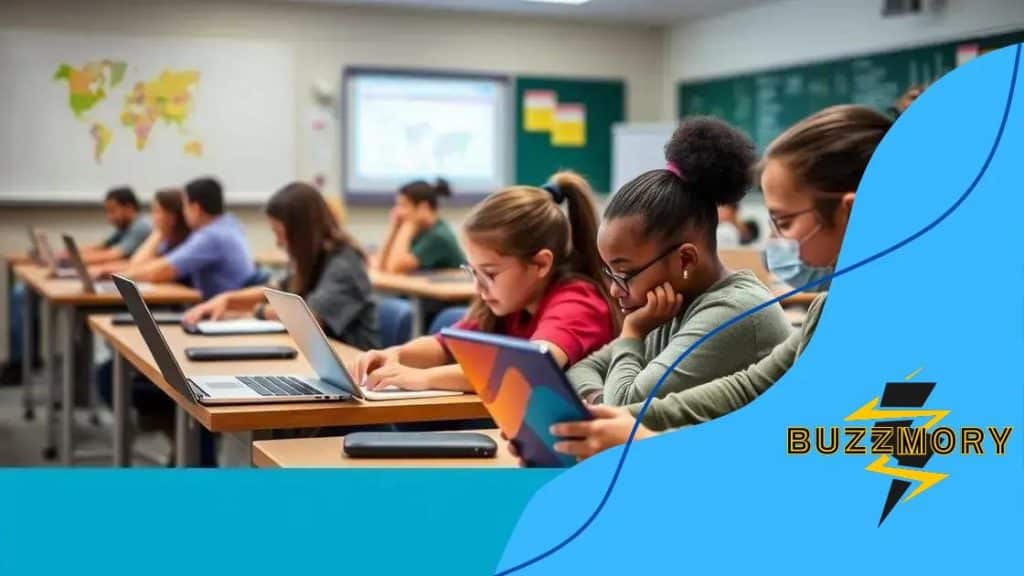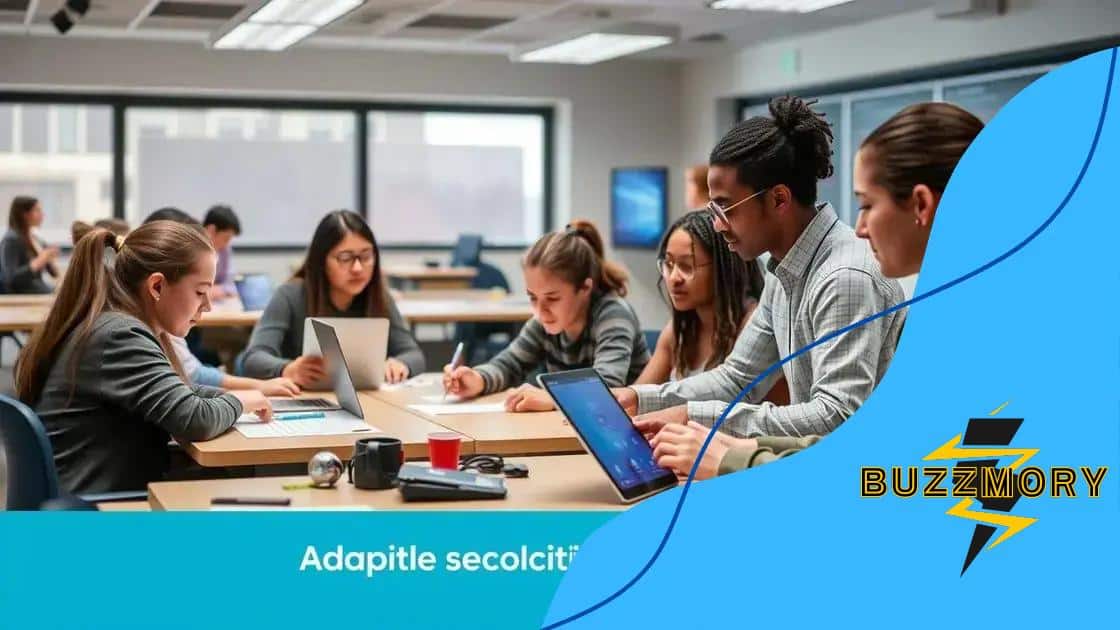How vocational education is adapting to the digital economy

Vocational education is adapting to the digital economy by incorporating technology training, hands-on experiences, and industry partnerships to ensure students develop relevant skills for today’s job market.
How vocational education is adapting to the digital economy is redefining how students prepare for their careers. As industries evolve, the emphasis on practical skills and digital proficiency has never been more critical. Let’s dive into those changes.
The role of technology in vocational education
Technology plays a crucial role in enhancing vocational education, making learning more interactive and relevant. It allows students to acquire vital skills needed for today’s digital economy.
Online learning platforms have revolutionized how vocational programs are delivered. Students can now learn from anywhere at their own pace, which increases accessibility and convenience. These platforms often include a variety of resources such as videos, quizzes, and forums to encourage engagement.
Benefits of Technology in Vocational Education
Integrating technology into vocational programs offers numerous benefits. Here are a few:
- Enhanced engagement: Interactive tools make learning more enjoyable and effective.
- Real-world simulations: Technology allows students to practice skills in simulated environments, preparing them for actual job situations.
- Access to up-to-date information: Students can stay informed about the latest trends and technologies in their fields.
- Collaboration opportunities: Online forums and group projects foster teamwork and communication skills.
Moreover, technology helps educators tailor their teaching methods to meet individual student needs. With data analytics, instructors can track progress and identify areas for improvement. This personalized approach ensures that students grasp important concepts effectively.
In vocational education, hands-on training is vital, and technology enriches this experience. For example, virtual reality (VR) and augmented reality (AR) are being used to simulate real-world work environments. This immersive approach enhances learning by allowing students to practice skills in realistic scenarios.
Emerging Technologies
As technology advances, new tools continue to emerge in vocational education. Educators are now utilizing artificial intelligence to create adaptive learning environments that adjust to student needs. This not only improves educational outcomes but also empowers students to take charge of their learning.
Furthermore, industry partnerships are becoming more common, where businesses collaborate with educational institutions to ensure that the curriculum aligns with market demands. This helps students learn the specific technologies and tools they will encounter in their careers.
In conclusion, the role of technology in vocational education is transformative and essential for adapting to the modern workforce. By embracing digital tools and innovative teaching methods, educators prepare students for success in an ever-evolving job market. This ensures that they possess the skills needed to thrive in their chosen fields.
Skills needed for the digital economy
In the rapidly changing landscape of the digital economy, individuals must acquire a diverse set of skills to stay competitive. Being successful today requires more than just technical know-how; it involves a blend of various capabilities that adapt to new challenges.
Technical skills are fundamental in this environment. Familiarity with software, coding, and data analysis opens many doors for job seekers. Employers increasingly look for candidates who can use technology effectively in their roles.
Essential Skills for Success
Below are key skills necessary for thriving in the digital economy:
- Data literacy: Understanding data analytics helps individuals make informed decisions.
- Digital communication: Strong communication skills are vital for collaborating with teams across various platforms.
- Creativity: Innovative thinking leads to new solutions and enhances problem-solving abilities.
- Adaptability: Being flexible allows individuals to embrace changes quickly and efficiently.
Additionally, soft skills play a significant role in the digital workspace. As organizations become more agile, teamwork and collaboration are essential. The ability to manage time effectively and work under pressure is critical in achieving project goals.
Moreover, having a growth mindset can set candidates apart. This attitude encourages continuous learning and improvement, which is necessary for staying relevant in today’s job market. With technology evolving, the willingness to learn new tools and methodologies is vital.
The Importance of Lifelong Learning
In the digital economy, the concept of lifelong learning is key. Pursuing additional certifications or participating in workshops helps individuals keep their skills updated. Online courses can significantly enhance a person’s qualifications without the need for a formal degree.
Employers appreciate candidates who take the initiative to develop new skills independently. Engaging in educational opportunities demonstrates motivation and forward-thinking, both of which are highly valued in the workforce. By continually enhancing their knowledge base, individuals position themselves as attractive candidates.
Lastly, building a network is essential. Connections made through social media or professional organizations can lead to opportunities and collaborations. Networking provides insights into industry trends and helps individuals discover which skills are in demand.
How institutions are adapting programs

Institutions are evolving in response to the demands of the digital economy. By adapting their programs, they ensure that students gain the skills needed for success. This transition involves a reevaluation of curricula to include modern technologies and methodologies.
One prominent change is the incorporation of project-based learning. This approach allows students to work on real-world projects, enhancing their practical skills while applying theoretical knowledge. Engaging in projects fosters problem-solving and critical thinking, preparing students for actual workplace challenges.
Updating Curriculum Content
To keep up with technological advancements, institutions are continuously updating their curriculum content. Here are some strategies they employ:
- Industry partnerships: Collaborations with businesses help educational institutions tailor programs to meet market needs.
- Incorporation of new technologies: Integrating tools like AI and data analytics into programs ensures that students are proficient in current technologies.
- Feedback from employers: Gathering input from industry leaders allows schools to adjust courses and focus on in-demand skills.
- Flexible learning environments: Offering both in-person and online options caters to diverse learning preferences and schedules.
Moreover, institutions are emphasizing the importance of soft skills alongside technical expertise. Communication, teamwork, and adaptability are now essential components of vocational training. By focusing on these skills, schools aim to produce well-rounded graduates who can thrive in various work environments.
Another notable adaptation is the integration of online learning platforms. These platforms provide students with the flexibility to learn at their own pace. By offering a range of resources, such as video tutorials and interactive exercises, institutions make education more accessible and engaging.
Experiential Learning Opportunities
Experiential learning is another key trend. This method provides students with hands-on experience in their chosen fields. Internships, apprenticeships, and co-op programs allow learners to apply their skills in real-world settings. This not only enhances their understanding but also boosts employability.
Furthermore, institutions are investing in faculty development. Training educators to embrace new technologies and teaching methods ensures they can effectively guide students through their learning journeys. With educators well-versed in modern pedagogies, students receive a quality education that prepares them for the future.
The impact on job readiness
The impact of vocational education on job readiness is significant in today’s competitive job market. By focusing on practical skills and real-world applications, vocational programs prepare students to meet employer expectations.
One major factor contributing to improved job readiness is hands-on training. This training allows students to learn by doing, which helps them understand job tasks better. Whether through internships or simulations, real-world experiences build confidence and competence.
Skills Development
In vocational education, developing relevant skills is paramount. Here are several skills that students refine:
- Technical skills: Proficiency in specific tools and technologies related to their field enhances employability.
- Interpersonal skills: Collaboration and communication abilities are critical for teamwork in professional settings.
- Problem-solving skills: Learning how to troubleshoot and solve issues prepares students for real workplace challenges.
- Time management: Managing their time effectively ensures that they can meet deadlines in fast-paced environments.
Moreover, vocational education often aligns closely with industry needs. Many programs collaborate with local businesses to ensure that students learn skills that employers seek. This connection between education and employment strengthens job readiness significantly.
Another important aspect is the teaching of workplace etiquette. Students learn how to interact professionally, understand workplace cultures, and adapt to different environments. This knowledge is crucial for successful entry into the workforce.
Certification and Credentials
Obtaining relevant certifications also boosts job readiness. Many vocational programs offer certification upon completion, which demonstrates to employers that a candidate has the skills required for the job. This recognition can set candidates apart in the hiring process.
Additionally, vocational education instills a sense of responsibility in students. Completing a program fosters accountability and prepares them for the demands of a work environment where meeting expectations is key. This sense of responsibility enhances their competitiveness in the job market.
Overall, vocational education equips students with the skills, knowledge, and mindset necessary for success in their careers. The focus on practical training and alignment with industry standards ensures that graduates are ready to step into their roles with confidence.
Case studies of successful adaptations
Case studies of successful adaptations in vocational education illustrate how institutions have effectively adjusted to the demands of the digital economy. These examples highlight innovative practices that enhance student learning and employability.
One notable case is the integration of technology training at a community college in California. They introduced specialized courses on digital marketing and data analytics. These courses were developed in partnership with local companies, ensuring that the curriculum matched real-world needs. As a result, students gained hands-on experience with industry-standard tools, making them job-ready upon graduation.
Another Example: Hybrid Learning Model
A tech school in Texas adopted a hybrid learning model, combining online and in-person instruction. This approach allows students to learn at their own pace while still receiving valuable face-to-face support. Students appreciated the flexibility and reported increased engagement. By using interactive platforms, instructors could track progress and provide personalized feedback.
- Increased student satisfaction: Students felt more in control of their learning experience.
- Broader reach: The model attracted a larger, more diverse student population.
- Active learning: Blended learning promoted hands-on projects that solidified understanding.
In another success story, a vocational school in New York revamped its curriculum to include advanced manufacturing skills. They collaborated with local manufacturers to identify skill gaps and designed courses that focused on 3D printing and robotics. This collaboration led to internships where students could apply newly acquired skills in real manufacturing settings. Graduates from this program received job offers from several partnering companies, showcasing how tailored vocational programs meet industry demands.
Additionally, a culinary institute in New York implemented virtual reality (VR) technology to enhance practical training. Students used VR to practice cooking techniques and plating presentations in an immersive environment. This innovative approach provided safe, repetitive practice opportunities. Students expressed confidence in their skills when transitioning to real kitchens, leading to higher job placement rates.
The Role of Feedback
These case studies share a common theme: the importance of adapting programs based on feedback from students and industry partners. By engaging with employers, schools can keep pace with the changing job landscape. This creates a workforce that is not only skilled but also relevant to the current market.
Overall, these successful adaptations serve as blueprints for other educational institutions looking to enhance their vocational programs. Through creativity and collaboration, schools can effectively prepare students for the challenges of the digital economy.
FAQ – Frequently Asked Questions about Vocational Education and the Digital Economy
How does vocational education prepare students for the digital economy?
Vocational education provides students with practical skills and hands-on training, ensuring they are job-ready and able to meet industry demands.
What role do industry partnerships play in vocational programs?
Industry partnerships help schools align their curricula with current job market needs, offering students relevant skills and job opportunities.
What are some examples of successful adaptations in vocational education?
Successful adaptations include integrating technology training, hybrid learning models, and experiential learning opportunities that enhance student engagement and employment prospects.
How important is feedback from students and employers?
Feedback is crucial as it helps institutions continually improve their programs, ensuring they remain relevant and effective in preparing students for the workforce.





